
- Index
- Listed By
- Maker
- A P Donnaghho (8)
- A.p. Donaghho (10)
- Adam Caire (7)
- Cowden & Wilcox (16)
- E & L P Norton (8)
- E.w. Farrington (11)
- Fulper (6)
- Hamilton & Jones (23)
- J & E Norton (9)
- Red Wing (171)
- Red Wing Stoneware (7)
- Redwing (10)
- Robinson Ransbottom (18)
- Unknown (233)
- Unkown (6)
- West Troy Pottery (6)
- Western (8)
- Western Stoneware (24)
- Westerwald (8)
- Whites Utica (10)
- ... (4975)
- Material
- Ceramic (10)
- Ceramic & Porcelain (386)
- Ceramic Stoneware (2)
- Ceramic, Stoneware (9)
- Clay (47)
- Clay & Dough (231)
- Clay, Stoneware (2)
- Crock (5)
- Metal (2)
- Pottery (32)
- Stone (53)
- Stone Ware (4)
- Stoneware (941)
- Stoneware / Pottery (2)
- Stoneware Clay (4)
- Stoneware Pottery (41)
- Stoneware, Pottery (2)
- Stownware (3)
- Wax (4)
- Wood (4)
- ... (3790)
- Signed
- Style
- 15 Gallon Crock (7)
- American (9)
- American Primitive (71)
- American Stoneware (8)
- Americana (957)
- Antique (357)
- Art Deco (14)
- Country (144)
- Country Americana (10)
- Crock (27)
- Early Texas Pottery (6)
- Farmhouse (19)
- Folk Art (13)
- French (7)
- Jug (12)
- Naive, Primitive (301)
- Primitive (36)
- Rustic / Primitive (153)
- Stoneware (8)
- Victorian (12)
- ... (3403)
- Type
- Bowl (4)
- Butter Churn (6)
- Butter Churn Crock (5)
- Butter Crock (9)
- Cookie Jar (46)
- Crock (511)
- Crocks (195)
- Jar (10)
- Jars (5)
- Jug (125)
- Jug Bottle (6)
- Kitchen Equipment (39)
- Moonshine Jug (10)
- Pottery (1000)
- Pottery - Stoneware (6)
- Pottery Crock (5)
- Stoneware (24)
- Stoneware Crock (53)
- Stoneware Jug (20)
- Stoneware Pottery (6)
- ... (3489)
3 Antique Westerwald German Salt Glazed Crocks Blue Cobalt Design



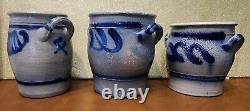

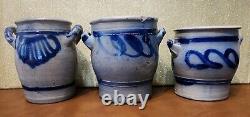
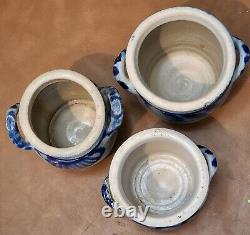
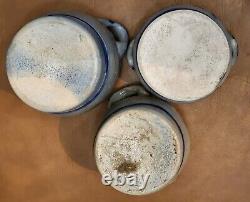

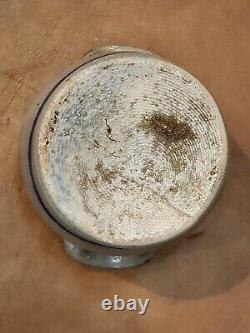
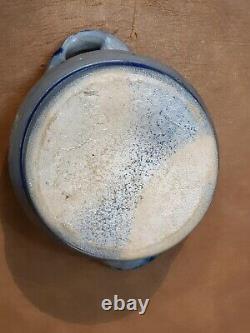
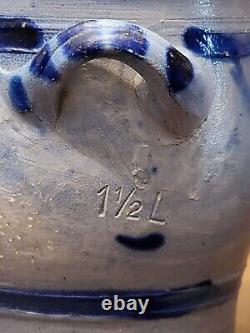
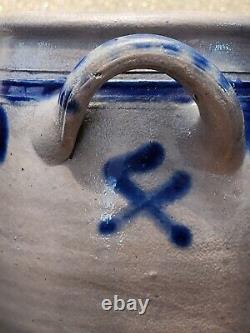

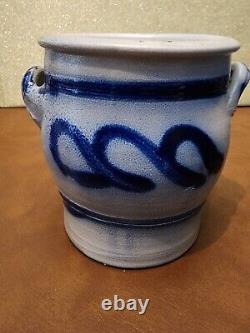
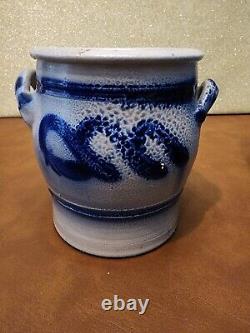
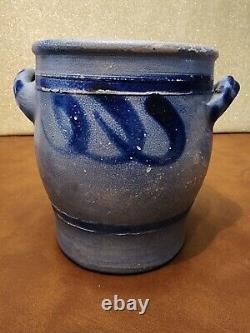





These blue and gray salt glazed pots & pitcher are hand-thrown. Each crock features a hand-painted scroll-type motif in a striking shade of cobalt blue. The cobalt decoration on these three pieces continues with lower and upper lines circling the crock and cobalt decor on & under each of the handles. 6 Length (handle to handle). 7 Length (handle to handle). History of salt-glazed pottery: Westerwald Pottery (stoneware) is a distinctive type of salt glazed grey pottery from the area of Westerwald in Rheinland-Pfalz, Germany. The clay of the area is almost free of impurities and is perfectly suited for stoneware production.
The earliest known production of salt-glazed stoneware was around 1402. Westerwald uses clay that is impermeable, which makes it adept for holding liquids. The clay is also typically gray or buff in color and maintains that shade through firing. In order to shape the clay, it was wheel thrown, and then templates were used to get it into the desired vessel form.
Once this was completed, the piece would then be fired at approximately 1200 degrees Celsius. What makes this particular ceramic unique is the salt-glaze.Towards the end of firing, salt is thrown into the kiln with the clay and vaporizes from the heat, creating a clear, glossy surface with a texture similar to an orange-peel Another typical addition during firing is the chemical compound cobalt, since it can withstand the high temperatures required and add a blue hue to the ceramic. Please see photos for visual description and for proof of current condition. Any condition statement given is a personal opinion. I research every item and describe items to the best of my ability. I encourage potential buyers to also research my items, especially if they feel there is any question of accuracy in my listing.
I always refer to viewing pictures for the best description. Thank You for stopping by to look!
Feel free to stay a while and browse the many other items I have available to make their way to you!

